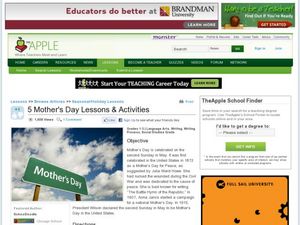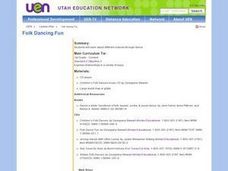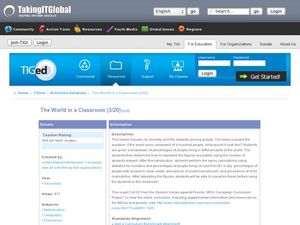Curated OER
Remembering Our Veterans
Eighth graders research a variety of military statistics while using the theme of Remebering Our Veterans. They use data management to plan and create a PowerPoint presentation with their findings. They incorporate different types of...
Alabama Learning Exchange
Probability with Tree Diagrams
Middle school math whizzes view a PowerPoint tutorial on tree diagrams. Using "Anthonio's Pizza Palace," an interactive activity involving the selection of pizza toppings, they use Pascal's triangle as a tree diagram. This is an...
Curated OER
5 Mother's Day Lessons and Activities
Students complete a craft project. For this Mother's Day lesson, students learn about Mother's Day around the world, write an essay about their mother, create a Mother's Day card, create coupons for meaningful time with their...
Curated OER
AIDS, HIV, & Other Microbe Matters
Young scholars conduct inquiry-based research for basic information about microbes, infections, and HIV, the virus that causes AIDS. After gathering answers to their questions, students develop a presentation to post on their school's...
Curated OER
The Rest of the Story
Third graders make predictions about the story "The True Story of the Three Little Pigs" based on background knowledge. They read the story, stopping to verify or reject predictions. They write their own opinionated fairytales.
Curated OER
Starquest
Students study the history and cultural interpretation of a celestial body or constellation. They create technology based presentations of the information.
Curated OER
The Princess And The Painter
Students discover Baroque art techniques through the research of Diego Velasquez' work "Las Meninas" and other Baroque art. This leads to an exciting creative art project of "everyday life" by each student.
Curated OER
Folk Dancing Fun
First graders discuss different kinds of music they have heard. They listen to a short selection of folk music and discuss where they think it is from. Using a globe, the teacher shows students where the music is from. They spread out on...
Curated OER
Classifying Plants and Insects
Art and science come together in a lesson based on Flower Still Life by Ambrosius Bosschaert the Elder. Learners classify plants and insects in the painting by color, leaf shape, size, reproduction, and season of bloom.
Curated OER
A Picture's Worth 500-700 Words: Neoclassical Painting Analysis and Creative Write
Students survey Neoclassical art and create a narrative based on their analyses. Focused questions and relevant background information provided by the Getty Museum provides a great foundation for students to understand art techniques as...
Curated OER
The World in a Classroom
Students calculate percentages of different kinds of people in the world. In this diversity lesson plan, students will see the percentages of different people and different incomes based on if the world only had 100 people in it.
Curated OER
Author of the Month
Fourth graders research authors on the Web each month in based on the themes in their reading book. They create an author booklet which includes a picture and biographical information.
Curated OER
Understanding Treaties: Students Explore the Lives of Yakama People Before and After Treaties
Students analyze treaties made between the US government and Native American tribes. In this government lesson, students evaluate bias emotionally connect with what was gained and lost during the late 1700's. This is a 3 part lesson...
Curated OER
Waste Aggregates and Material Properties
Students define specific waste materials that could be used as aggregate in concrete. In this aggregate and waste lesson plan, students brainstorm on how to incorporate waste in construction and define different aggregate materials.
Curated OER
Using Technology in Science
You can spice up your science content by incorporating technology into your lesson plans.
Curated OER
Design a Book Cover
Students explore character, plot, setting, symbolism, and conflict for a book that they are reading. Sample book covers are provided and students apply what they have learned by designing a book cover.
Curated OER
Animation Flip Books
Learners create an animation flip book. In this flip book lesson plan, students examine past animation, forces and motion, and visual arts by creating an animation flip book. Enrichment extension activities are included.
Curated OER
Veni, Vidi, Vici
Students participate in a Roman festival to complete a unit on Roman Civilization. In this Roman Civilization lesson plan, students learn about Cleopatra, Julius Caesar, the Mediterranean Region, and more. Students share what they...
Curated OER
Road Safety- Alert Communications and Emergency Response
Learners examine the effectiveness of road safety organizations. In this road safety lesson plan, students identify three road safety watch agencies that aid truck drivers to keep them safe. They look at the skills that truck drivers...
Curated OER
Places on the Planet: Latitude and Longitude
Students locate different places on globes and maps by learning about latitude and longitude lines. In this latitude and longitude lesson plan, students identify specific locations based on the degrees of latitude and longitude.
Curated OER
Robotics
learners identify and research robots in various roles in society, and create robotic arms and multimedia presentation based on their findings.
Curated OER
Studying An Artist
Students examine the artwork of a specific artist and attempt to create a painting in the style of the studied artist in this middle and high school level Art instructional activity. Rubric is included for self- and teacher assessment...
Curated OER
Write Your Own Rap
Third graders create a rap using basic AB form composition. Evaluation of performances are based on rubric formed during the first lesson by all students. This three to four day lesson culminates in student performances and evaluation.
Curated OER
Nature Superfish
Students examine the billfish as a predator in the ocean. In this ocean, creatures, and tides lesson plan, students view video clips and discuss the sea creatures and scientists in the videos. Students create their own videos. students...

























